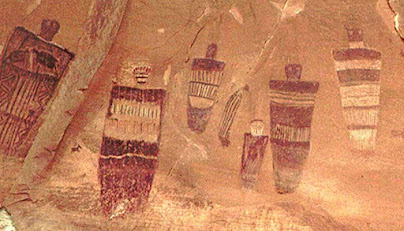Archeological
investigations at San Lazaro rock shelter near Segovia in central Spain turned
up a number of pebbles (rounded river rocks) that showed signs of percussion,
they had been used as hammerstones.
Among them
was a somewhat larger piece of rock that had no evidence of being used as a
hammerstone, but had a small, round red dot of ocher paint on it. “Twenty-three pebbles of leucogranite and gneiss have
been found in level H, most of them used as hammerstones, showing extensive
evidence of percussion marks. These pebbles have been analyzed for comparison
with the leucogranite pebble studied in this paper. All pebbles with traces of
use as hammerstones are predominantly sub-rounded or small oval shapes, with
none exceeding 11 cm in their longest axis. No other pebble displays traces or
remains of ocher, nor do they have natural concavities or cupules.” (Alvarez-Alonso et al. 2025: 9)
The red dot in the center of one face of the rock was midway between two indentations at one end and a single indentation at the other end. If one were to think of these indentations as eyes and a mouth then the red dot is precisely placed to mark the position of a nose.
Assuming
that the red dot had been applied with a fingertip, the team (Alvarez-Alonso
et al. 2025) arranged for a police forensic lab to examine it. “Determined
to test their conviction that the red mark was a human fingerprint placed
deliberately between the indentations that could have been the eyes and mouth
of a face, the team enlisted the help of other experts. Further investigations
confirmed that the pigment, which contained iron oxides and clay minerals, was
not found elsewhere in or around the cave. ‘We then got in touch with the
scientific police to determine whether we were right that the dot had been
applied using a fingertip,’ said Alvarez Alonso. ‘They confirmed that it had.’
The print, they concluded, was human and could be that of an adult male.” (Jones 2025) I assume that the
phrase ‘scientific police’ in the preceding paragraph refers to a police
forensic laboratory.
“The object to be analyzed in detail is a quartz-rich granite pebble, with a sub-ellipsoidal-planar morphology (21.4 × 11.3 × 7.6 cm). On one of its faces, the pebble has three small cupules and at the center of these, positioned centrally relative to the three marks, a sub-circular red dot is visible on its surface.” (Alvarez-Alonso et al. 2025:6)
So the
question then became ‘why was such a fingerprint so carefully been placed on
this stone? “Once we had that and all the
other pieces, context and information, we advanced the theory that this could
be a pareidolia [catching sight of a face in an ordinary, inanimate object]
which then led to a human intervention in the form of the red dot,’ said the
archaeologist. ‘Without that red dot, you can’t make any claims about the
object.’” (Jones 2025)
It was
discovered that the particular layer that this was excavated from had to be
Neandertal in age. “Several
14C-AMS dates have been
obtained to contextualize the find chronologically, both for Level H itself and
for one of the upper archeological strata, Level D. The results range from 43 ky
cal BP for Level H to 42.5–42.1 ky cal BP for Level D, on samples of horse
teeth.” (Alvarez-Alonso et al. 2025: 6)
So we have
the intentional application of paint to a rock – rock art! This is my excuse
for writing this, but I am also excited about it being a genuine Neandertal
fingerprint.
However,
this is not the first Neandertal fingerprint discovered. And as impressive as a
date of 43ka is, the first one found was much older. “Even more complex demonstrations of Neanderthal hafting technology. In
the 1970s archaeologists excavating another German brown coal mine at Konigsaue
found two small black lumps from a lakeside excavation, dating around 85 to 74
ka. One had certainly been part of a composite tool: three surfaces bore
imprints of a lithic tool, a wooden surface and the unmistakable whorls from a
partial Neanderthal fingerprint. It was only in 2001 that chemical analysis
identified unique biomarkers from birch trees: specifically, tar derived by
cooking the bark in low-oxygen conditions.” (Sykes 126) This technology has
since been replicated numerous times through experimental archaeology.
So, two
Neandertal fingerprints, this is something that could not have even been
imagined when I was in school – amazing.
NOTE: Some images in this posting were retrieved from the internet with a search for public domain photographs. If any of these images are not intended to be public domain, I apologize, and will happily provide the picture credits if the owner will contact me with them. For further information on these reports you should read the original reports at the sites listed below.
REFERENCES:
Alvarez-Alonso, David et al., 2025, More than a fingerprint on a pebble: A pigment-marked object from San Lazaro rock shelter in the context of Neanderthal symbolic behavior, 5 May 2025, Archaeological and Anthropological Sciences (2025) 17:131. Accessed online 28 May 2025.
Jones, Sam, 2025, World’s oldest fingerprint may be a clue that Neanderthals created art, 26 May 2025, The Guardian online, https://www.theguardian.com. Accessed online 28 May 2025.
Sykes, Rebecca Wragg, 2020, Kindred: Neanderthal Life, Love, Death and Art, Bloomsbury Sigma,
London.
V


























